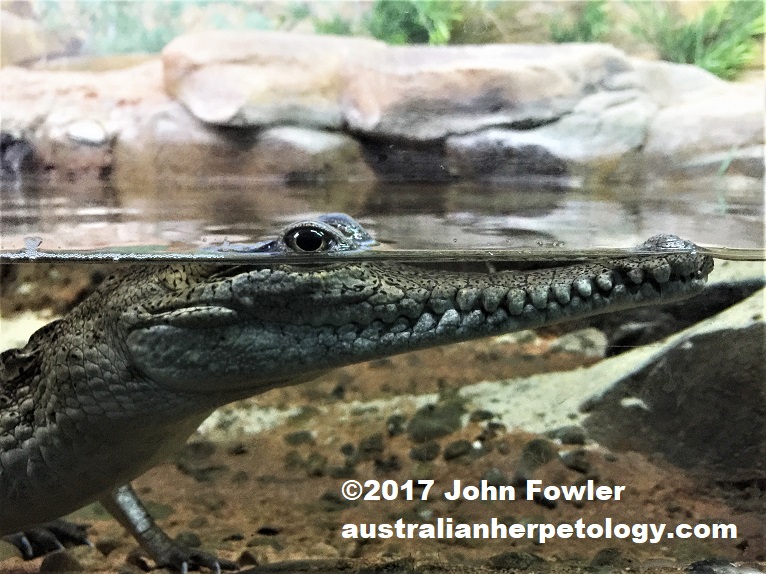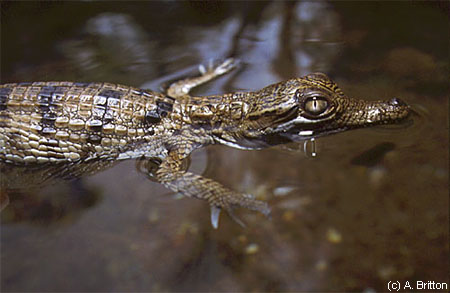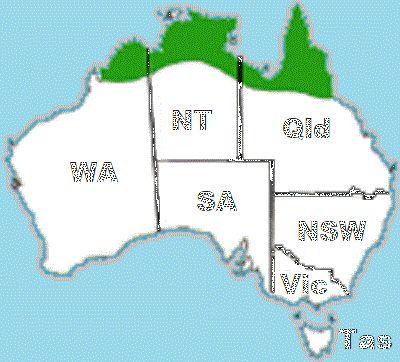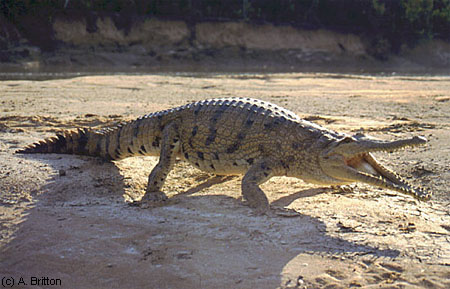|
|
|
|
|
|
|
|
|
|
|
|
|
|
|
|
|
|




Habitat
Australian freshwater crocodiles (Crocodylus johnstoni KREFFT 1873) are endemic to Australia and are distributed throughout the coastal and more inland regions of the north, from Western Australia to Queensland.
Freshwater crocodiles are generally found upstream of tidal influence, in lower salinity water. They are actually fairly tolerant of saltwater, yet Saltwater Crocodiles (Crocodylus porosus) aggressively outcompete them in most areas where they occur. Main habitats include wetlands, rivers, creeks, freshwater billabongs and swamps. They display fairly wide habitat preferences (clear water, muddy, still, fast flowing, shallow or deep).
At the end of the wet season (in April), freshwater crocodiles move to areas of more permanent water for the duration of the dry season. Feeding and growth normally cease entirely. Some individuals may burrow into river banks, and well-established burrows exist. At the end of the dry season, they relocate to wet season habitat using a well-honed homing instinct. They use the wet season for feeding and dispersal.
Feeding
Hatchlings first absorb their yolk sac, on which they can thrive for days and even weeks if necessary.
Juveniles eat small prey - e.g. insects and other arthropods, crustaceans, small fish
Larger adults eat similar, but larger prey. Unlike Saltwater Crocodiles, adult freshwater crocodiles will still take small prey as well as larger prey such as amphibians, reptiles, bats, birds, and primarily fish (for which their jaws are suited).
Feeding tactics involve waiting at the water's edge for prey to come within range. They do not hunt on land, but will take terrestrial prey close to the water's edge. Larger animals will sneak up on prey in the water, submerging some distance away, and attacking from below.
They ingest small stones and pebbles called "gastroliths" which are used in digestion (to grind up food in the gizzard), and also to aid in maintaining buoyancy in larger animals (by acting as a ballast).
Nesting
Courtship occurs in the middle of the dry season during July, and nesting occurs over a 2 to 3 week period during August. Freshwater crocodiles dig hole nests in sandy river banks, as nesting materials are unavailable during the dry season. As the eggs are closer to the ground water table, they are more susceptible to flooding at the start of the wet season - particularly if heavy rains occur early. The nest is normally dug within 15 metres of the water, and egg laying occurs at night to reduce risk to the female.
Female freshwater crocodiles are known to dig communal nests, within one or two metres of each other. Females sometimes accidentally dig up the eggs of other females while digging their own hole. Females tend to return to the same nesting sites year after year.
Although the female remains close to the nest, she generally does a poor job of defending it. Hunting from Aboriginals may have changed this behaviour over time by making females more wary of intruders. Most nests (over 80%) are destroyed by predators such as Varanus gouldii (Gould's sand monitor), Varanus panoptes (Yellow spotted monitor) and feral pigs (Sus scrofa).
Mean clutch size is around 13 eggs, although studies in Queensland indicate slightly larger clutches may occur there. The largest clutches are laid at the start of the nesting period. Incubation period is around 74 to 80 days, depending upon temperature.
As with all crocodilians, sex is determined by temperature during incubation. Between 31 and 32 degrees C, mostly males are produced. More females are produced at warmer and cooler temperatures.
Females revisit the nest site around hatching. Vibration (caused by the female traversing the area) stimulates the hatchlings to call from within the eggs, which in turn stimulates the female to begin opening the nest. The nest-opening female may not necessarily be the parent.
Eggs start off translucent, and quickly become opaque due to fluid absorption from the albumen.
Hatchlings possess a small egg tooth to split the egg membrane, but they are often assisted by the female who will gently crush the egg shell to open it. She will then carry hatchlings to the water in her mouth (which distends to carry several), although sometimes injuries to the hatchlings can occur from her sharp teeth.
Hatchlings form a creche (less than 10 animals usually), with which the female may remain for a few weeks. Hatchlings produce agitated vocalisations if disturbed which warns other hatchlings, and attracts the female. Freshwater crocodiles tend to be less vigilant than Saltwater Crocodiles, however, and the hatchlings disperse more quickly.
Hatchling mean mass is around 42 grams, and the mean size is around 24 cm.
Hatchling predators include birds (e.g. black and whistling kites), other crocs, turtles and even large fish. Like Saltwater Crocodiles, it is cannibalism which is one of the major causes of mortality in young crocodiles.
Initial predation is very high, and less than 1% of all the initial eggs laid will produce a mature adult crocodile.
Growth
Growth is highly variable, and is influenced by environmental, habitat, genetic and dietary factors. Nearly all growth occurs during the wet season, where food intake is high. Freshwater crocodiles grow much more slowly than Saltwater Crocodiles.
Size: males reach 2.4 - 3.0 m (53 kg) or 8 - 10 feet maximum, females reach 2 m (6.5 feet) maximum. Age: maximum rarely exceeds 50 years. It takes 20 years for a juvenile to grow to its maximum size, although growth will continue at a slower rate throughout life (hence it is difficult to predict maximum size). Growth is also affected by food intake, temperatures, and social factors (e.g. stress).
Males reach sexual maturity at 87 cm SVL (snout vent length) at 16 - 17 years old. Females mature earlier at 74 - 78 cm SVL, around 11 - 14 years old.
Conservation
Freshwater crocodiles were hunted for 4 years in N.T. and 14 years in Queensland. In that time, the population went from being "plentiful" to being "rare". They were protected in 1962 (N.T.), 1964 (W.A.) and 1974 (Qld.). It took until 1980 for the population to show significant recovery.
The population of crocodiles (saltwater and freshwater) is kept in check by cannibalism - larger crocodiles are a significant cause of juvenile mortality. The more adult crocodiles around, the greater the degree of population control on the juveniles. This aspect to the population balance is one of the many things disrupted by excessive poaching / hunting of adults. Today, there is no harvesting of freshwater crocodiles as their skin is worth very little next to a Saltwater Crocodile's skin.
The major current threat to the population is habitat loss for farmland and development, although freshwater crocodiles are not considered to be under immediate threat. Remaining habitat therefore needs to be given some "income earning" potential - i.e. some value.
Public education is also important. Freshwater crocodiles are not considered "dangerous", unlike Saltwater Crocodiles, but their bite can still inflict serious injury if they are provoked.
Dr. Britton is from England, but has travelled widely in his studies of crocodilians. He is currently engaged in research in Australia. Some of his work may be viewed at:-
CROCODILIANS: Natural History and Conservation.
OTHER LINKS OF INTEREST
AUSTRALIAN CROCODILES
by John Fowler
CROCODILES OF THE WORLD
by John Fowler
ESTUARINE (or SALTWATER) CROCODILE
Crocodylus porosus
Reptiles of the Australia